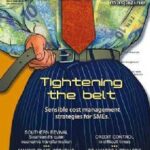SORTING THE PAYROLL
Having your payroll sorted is vital to good employee morale. A suitable payroll system can also make a significant contribution to the bottom line. By Kevin Kevany.
peak to the founder-entrepreneurs and managers of successful and enduring businesses – from the classic SME to the venerable corporates – and to a person they confirm the quickest way to destroy their brand would be to ‘white-ant’ their employee security.
And the simplest way to do that is to create a pattern of erratic salary payments and deductions which appear to have been created by a ham-fisted Lotto operator. Dissatisfaction is instant. Morale plummets. Customers sniff and assume a pending financial crisis and move their business elsewhere.
"Payroll" was for many years a secret, dark-art, practiced in the bowels of companies by a miserable and wholly-dependent relative of the founder, inspiring fear and loathing, and brooking no questions or queries. Speculation abounded on whether an abacus or a faulty calculator was used as an aid.
And then came 2008. It was the year, one of the vendors of payroll services said, subject to total confidentiality, "when the Government and the IRD combined to market our services, at no cost".
"There are now at least 13 pieces of relevant legislation – including PAYE, annual leave and Kiwisaver – payroll professionals need to be aware of. Add to that the regularly changing tax regime, increased time pressures and extra responsibilities, and many businesses are finding they need support and assistance to manage their payroll and ensure they stay compliant," says MYOB New Zealand general manager, Julian Smith.
"Changes to legislation have meant payroll is processed differently, and in turn, to the way many companies now view their payroll processing needs. 2008’s new payroll compliance challenges have made paying staff that little bit harder."
Not that it wasn’t hard enough before. Listen to this explanation of a minor aspect of the legislation changes – and weep.
"Under the old Act, ‘holiday pay’ was calculated based, on average, when the leave became due and only changed if this was lower than the individual’s pay rate when it was paid out. Under the latest Holiday Act, the calculation of holiday pay is based on the average of the 52 weeks prior to an employee taking leave – this means the value of an employee’s leave can change from week to week.
"Both the value of the holiday being paid to the employee, as well as the company’s holiday liability is constantly changing," explains Brook Ready, marketing manager of Datacom Employer Services.
But, as they say, "wait, there’s more":
• If an employee is a member of Kiwisaver and a complying fund and the company is making its Compulsory Employer Contributions to the fund, the employee cannot receive less than if it were paid under the Kiwisaver rules. This could mean additional calculations to ensure CEC is not under-paid.
• Employer Tax Credit (ETC) must be calculated and deducted before PAYE is paid to the IRD. This calculation is dependent on the number of days in a month, so the maximum amount that can be claimed per employee differs from month to month.
And before putting an end to the torture – "salary sacrifice" is now a growing trend, with employees opting to sacrifice part of their salary (pre- tax) directly to the "super" scheme.
Enough, you say. Bring me David Copperfield to "un-bamboozle" me.
But first, what are your options?
1. Do it yourself.
Why? Because you always have. You don’t like "that sort of information floating around the place" or someone else interacting with the IRD, as your agent. And you’ve never trusted Internet links. Besides, what would you do with Gertrude, who was the fourth employee to join the firm, and is now widowed? But you will have to wait for updates on your software or perhaps even buy a new version.
2. Farm it out to a bureau.
Why? Because it is their specialist business and you’ve always outsourced to experts, so you can focus on what makes you successful. It’s their problem to be up-to-date with legislation and advise you on changes. They’ll deal with the IRD – another chore taken care of. Best of all, it is off-site, so you don’t have the back-up hassle to contend with. The downside is that you have to comply with their proprietary system.
3. Log on to an online payroll service
.
Why? SaaS (Software as a Service) is the in-thing, the future. Without the hype it means you/your individual employees can access payroll information online. That lifts the burden on your administration immediately. Staff can book their leave, see how many sick days they’ve taken, etcetera. Best of all, provided you get the right provider to meet your needs, the service complies with your requirements and not the other way round. You have the option to have payroll processes and compliance fully or partially automated by the provider, based on your budget as well.
Some payroll options
Having profiled yourself – here’s a parade of vendors eager to please. MYOB has its origins in the software business, but it too has evolved with the trend.
"MYOB now helps pay over 40 percent of the country’s employees, through either dedicated payroll solutions or its outsourced payroll bureau. More than 80 percent of all electronic tax returns (1.3 million) were filed using an MYOB product in 2007," says Julian Smith.
"Where businesses are facing the challenges of a new economic environment – the last thing they want to do is risk extra cost by paying staff or tax incorrectly. The efficiencies a payroll system brings can also make a significant contribution to the bottom-line."
Their latest payroll upgrade – MYOB Payroll 2008.3 – released at the end of 2008, is right up to date on the latest compliance issues. EXO Assist Payroll Bureau has been designed for clients wishing to outsource all or part of their payroll – providing a convenient, flexible processing service scaled to their needs.
MYOB EXO Assist Payroll Bureau, when used in conjunction with MYOB EXO MyStaffInfo, allows staff to access their payslips and manage leave.
"Electronic filing to the IRD and direct credit transfer, using a client’s banking software, guarantee seamless paydays," says Smith, whose bureau team can also provide a payroll ‘warrant of fitness,’ system check, payroll entry, plus set-up and training for clients.
"With a slow economy, businesses look to make savings where possible. By automating Time and Attendance (T&A) they can see savings of up to five percent on payroll costs, ensuring accuracy of employee attendance and reducing human error," says Amanda Penny, marketing manager of iDT.
"The trend towards web-software is ever increasing. It’s in real-time, ensures scalability and with zero footprint, installation on individual workstations is eliminated, thereby reducing costs.
"iDT provides solutions for every segment of the market, from basic time clocks to enterprise solutions for larger companies. We provide top international products to the local market, backed up by full local support, with our commitment to service our greatest point of difference.
An automated T&A system, says Penny, can dramatically reduce the time it takes to process payroll, by eliminating the manual preparation, as well as distributing, collecting and calculating timesheets/timecards – with an anticipated 80 percent reduction in time.
Sitting neatly between iDT and MYOB is Datacom, a provider of payroll and HR services locally for more than 30 years. It offers a choice of payroll outsourcing, in-house and online payroll systems, plus takes care of all PAYE, e-filing and Kiwisaver troubles.
"EasiPay Online payroll outsourcing has been the original, pedigree payroll choice for businesses large and small in that time. Thousands of Kiwi companies and government departments have opted for a hassle-free, complete service with the ability to send and receive timesheets online, access historic reports and use our exclusive ‘Executive Dashboard’," says Datacom’s Brook Ready.
He reckons NetPay (SaaS Internet payroll) has done away with the need to use payroll software.
"It gives you control of your own payroll online, eliminates the need for the update and adjustment CDs that payroll software require. The best part is you can pay your employees from anywhere, anytime, with full free phone support included – even if you are out of the country."
Ready believes features like those computed by their Executive Dashboard – "an instant, current, graphical insight into the company" on staff service, leave accruals, leave-pay liabilities, etcetera – are part of the future direction of this sector, with vendors competing to add management aids offered free.
"Until 18 months ago, I would have said the trend was in-house and SaaS, but the tidal wave of changes, making payroll laborious and frankly tedious, have caused many to say ‘no thanks, this is not what I’m in business for’. Why try to build your own car?
"It’s got hard enough for even us guys who specialise in it. And I do not see this change being short-lived; rather rolling on for the next five to six years. Businesses are increasingly putting a value on their own time. So they hand it over to the experts, like us," Ready says.
IRD fines for late and inaccurate filing have been a turbo-boost to decide the waiverers to opt for e-filing on behalf of clients.
The evolving market
Back in the early 90s, in the crazy days leading up to the "dot.bomb" crash, Martin Gleeson and Cary Thomson, two bureau-payroll-software developer types got together and looked at the future; decided it was web-based payroll systems (an outrageous thought at the time given the lack of data security) and decided to do something about it. Today it’s called iPayroll, "one of the top two in the business", consistently innovative vendors of those systems, with offices around the country and a development and tech centre in Auckland.
That’s because Auckland is where the evolving market is and they are in the bespoke business.
"iPayroll evolved with Internet banking and that helped overcome client scepticism on security. Connectivity costs have plummeted from those early days, so a small customer down in Invercargill can today happily link up, without paying the fortunes those pioneering clients did," managing director Gleeson says.
Their smallest customer pays a single employee and their largest "many hundreds" – which they believe demonstrates the flexibility and cost-effectiveness of iPayroll’s service.
"And that’s reflected in our client base – big branch and franchise operators who find our offering attractive because it also delivers a consistency of accounting across all outlets, and companies with fewer than 10 employees, where the PC-based systems, the ‘shrink-wrap’ market, simply don’t make economic sense," adds iPayroll’s general manager and Auckland office boss, Cary Thomson.
"And we are effectively pay-as-you-go, with an opportunity to test the waters. We are registered PAYE intermediaries with the IRD and you can also use our services on your mobile."
Gleeson believes far too many SME operators don’t value their time sufficiently, spending endless hours, often late into the night, at a cost to their productive or personal time ("and sanity"), but "wrongly treat that as ‘free’ time when comparing costs".
Okay, so if you buy that, plus the fact that your payroll would be off-site, safe from fire, robbery, disk crashes and interminable legislative upgrades, how much would they charge to do the fortnightly payroll of a five person operation?
"Slightly under $500 a year, almost $100 per employee, but we do have a minimum charge of $35 a month as a start point. For that we do your banking, deal with the IRD for you and stay up-to-date with the legislation changes," Gleeson says.
Kevin Kevany is an Auckland-based freelance writer.
Email [email protected]



